When cops
become robbers
Inside one of America's most
corrupt police squads
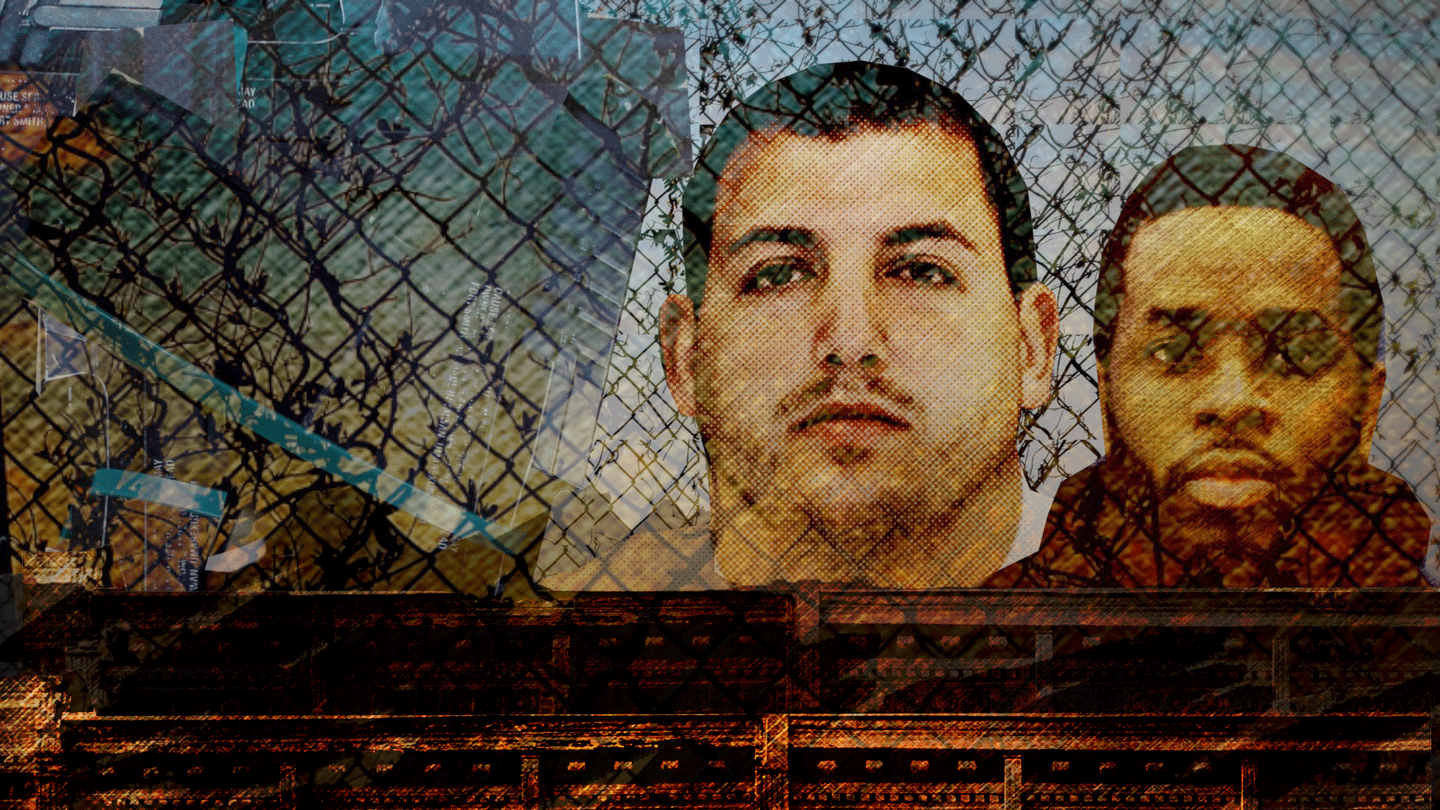
Parts of this story are reconstructed from trial testimony, evidence and publicly available records. It contains strong language throughout.
Four vehicles fly down a darkened, rain-soaked street. It’s summertime, nearly midnight in downtown Baltimore.
The lead car, a white Chevrolet, is driven by a 34-year-old man, his foot pressed to the pedal. On his tail are three unmarked police cars driven by members of the Gun Trace Task Force, a plainclothes gun recovery unit.
The chase started after the Chevrolet ran a red light. Pursuing the vehicle would be a violation of Baltimore Police Department policy, but the detectives suspect the man in the Chevy has guns, drugs, cash or all three.
“Might be able to get somethin’ dirty,” detective Daniel Hersl says excitedly.
“Light him up,” detective Jemell Rayam responds.
The pursuit proceeds to the sounds of revving engines and heavy rain pelting the windows - there are no sirens.
The Chevrolet blows through another red light. He almost makes it across the intersection when a Hyundai Sonata going through the green collides with the driver’s side of the Chevy, launching both cars up on to the pavement. The Chevy crumples into a motionless wreck.
“Shit!” exclaims detective Momodu Gondo from behind the wheel. “Damn.”
“Keep going,” responds his partner, Rayam. “I don’t know.”
“Shit!”
“I don’t know,” repeats Rayam. “I don’t know.”
Without stopping, the detectives radio back and forth between their cars.
“We ain’t look too crazy, did we?” asks Gondo. “They got cameras all up and down that shit.”
“I can get on the air and say I just got a report of an accident,” says Rayam.
“No, Wayne said - I wouldn’t say nothin’ yet,” responds Hersl.
Several blocks away, two of the three police vehicles pull to the side of the road and the officers confer. Gondo thinks he only had his lights on at the very beginning of the chase - maybe no one noticed them.
“That’s the thing with Wayne. He’s a little too much with this shit,” says Hersl. “These car chases. This is what happens.”
Eventually it strikes the officers that they never called for aid.
“How about we just go on scene and just act like, ‘Oh, is everything OK?’” asks Rayam.
“That dude unconscious, he ain’t sayin’ shit,” responds detective Marcus Taylor.
Listen to the Gun Trace Task Force before and after the car crash (WARNING - contains strong language)
Over half an hour after the crash, they’ve still done nothing. Hersl suggests they change their time cards to make it appear they stopped work hours earlier. Wayne Jenkins, the unit’s leader, stops to scope out the accident, but also does nothing to help.
“I wonder what was in that car,” says Hersl.
“I don’t care,” Jenkins snaps. “Go back to HQ.”
A year and a half later, in a federal courthouse in downtown Baltimore, a prosecutor switches off the audio recording from that night, captured on a FBI listening device hidden in Gondo’s police vehicle. On the witness stand sits Rayam, a tall, broad-shouldered man with a smooth pate. Instead of his police uniform, he wears bright orange prison garb.
Facing him from the defendants’ table are two of his former colleagues, Daniel Hersl and Marcus Taylor.
“None of us stopped to render aid or see if anyone was hurt,” Rayam tells the courtroom in a faltering voice. “We were foolish, I don’t know, we just didn’t… we just didn’t stop.”
In the case of United States versus Daniel Hersl and Marcus Taylor, the car accident is the least of the men’s legal worries. They are facing multiple counts of extortion, racketeering and fraud for their part in what prosecutors call a “perfect storm” of police officers gone rogue. Rayam, Gondo, Jenkins, as well as two other officers from the Gun Trace Task Force have already pleaded guilty.
When the prosecutor finishes his questions, Rayam seems to completely fall apart. He shields his eyes from the jury.
In an already exceptionally dramatic trial, it is a disorientating moment. As Rayam - a once-respected police detective, a college-educated father with a nice house in the suburbs - sobs silently on the witness stand, it is impossible not to wonder...
What happened to these police officers?
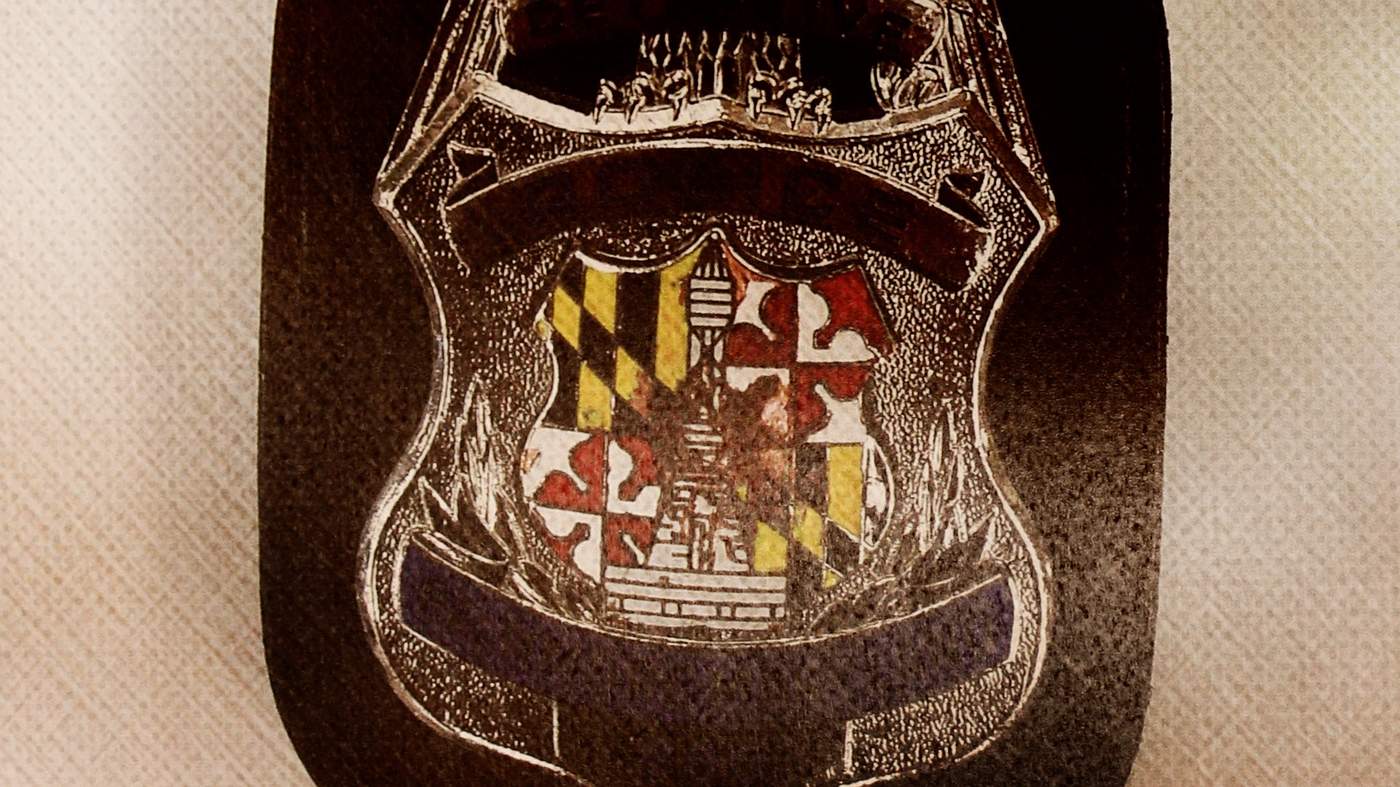
Here’s what the public was led to believe about the Gun Trace Task Force, before the FBI arrested almost every member of the squad:
That in a city still reeling from the civil unrest that followed the 2015 death of Freddie Gray in police custody, the GTTF was a bright spot in a department under a dark cloud. The 25-year-old African-American man’s death after a ride in a police transport ignited a build up of decades of tension between Baltimore's black residents and the police, touching off days of demonstrations, including looting and violence.
That while the homicide rate was on a historic rise, this elite, eight-officer team was getting guns off the streets at an astonishing rate - their supervising lieutenant praised “a work ethic that is beyond reproach” that resulted in 110 arrests and 132 guns confiscated in a 10-month period.
That the GTTF’s leader, a former Marine and amateur MMA fighter named Sergeant Wayne Jenkins, was a hero who’d plunged into a violent crowd during the unrest to rescue injured officers, an act of bravery that earned him a departmental Bronze Star.
But when the sun came up on 1 March 2017, the city awoke to a vastly different reality.
Seven officers were arrested and indicted for racketeering, extortion and fraud: Sergeant Jenkins; Detective Daniel Hersl, a 17-year veteran of the force; longtime partners Detectives Momodu Gondo and Jemell Rayam; and Detectives Maurice Ward, Evodio Hendrix and Marcus Taylor. Only one member - oddly enough, John Clewell, the man whose name triggered the entire investigation - escaped indictment. The FBI found he was never a part of the criminal enterprise.
“They were involved in a pernicious conspiracy scheme that included abuse of power,” the US Attorney for Maryland told reporters that day. Police commissioner Kevin Davis, who’d once praised the men’s work, now likened them to 1930s-style gangsters.
“It’s disgusting,” he said.
The public soon learned that the GTTF stole from drug dealers, but also from a homeless man, a car salesman, a construction worker and many others. The victims were overwhelmingly African-American.
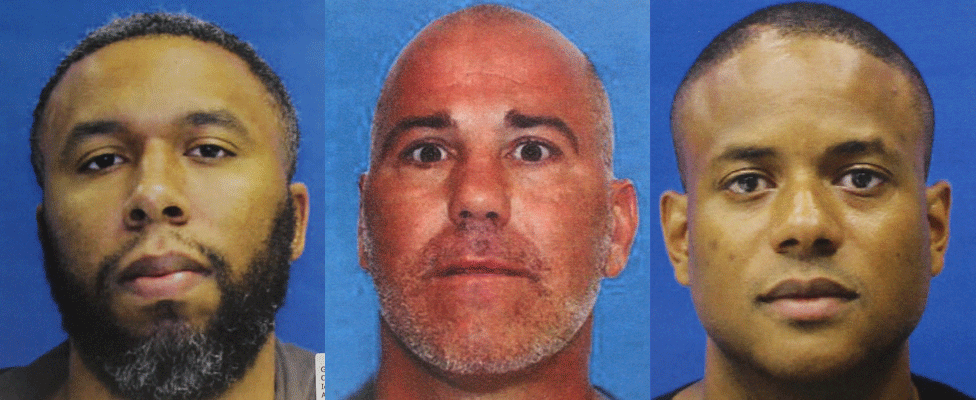
Evodio Hendrix, Daniel Hersl, Jemell Rayam
That they received hundreds of hours of overtime, when they were actually at the bar or on the beach, from a city that struggles to keep the heat working in its schools.
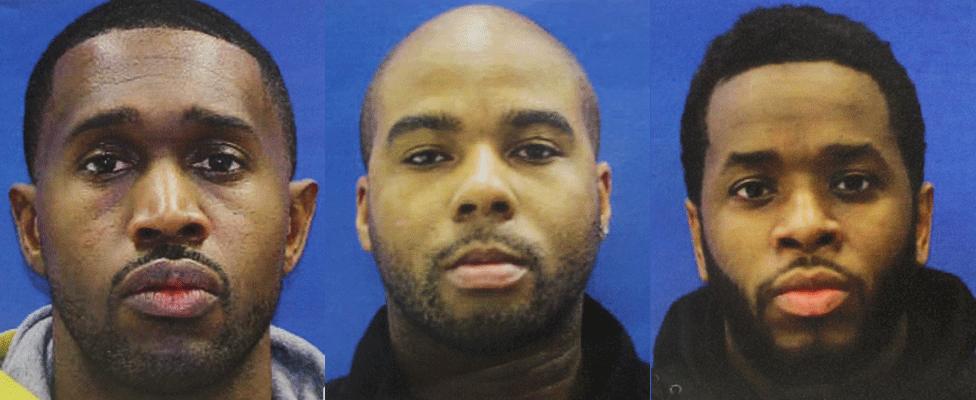
Maurice Ward, Marcus Taylor, Momodu Gondo
That during the unrest, Jenkins was stealing garbage bags of opiates from pharmacies, and that he also stole and re-sold heroin, Ecstasy, crack and cocaine.
That he planted drugs on innocent people, and was slowly building up the courage and the arsenal to commit fully-fledged burglaries.

Wayne Jenkins
“They owned the city,” shrugged one witness who admitted to acting as the fence for Jenkins’ stolen goods. “It was a front for a criminal enterprise.”
The revelations crescendoed in an explosive three-week trial in federal court which drew back the curtain on a phenomenon extensively explored by Hollywood but rarely witnessed in real life: the inner workings of a police unit gone rogue, and the path of human destruction left behind it.
In a city just coming off the highest murder rate in its recorded history, some residents wonder how much of that violence can be attributed to a citizenry that felt abandoned by its police force.
“Their behaviour had to have contributed to the uptick in violence, there’s no way it didn’t,” says one retired BPD detective. “The police department thinks they can kind of push right past it.”
Even after the arrests, victims of the GTTF say they don’t believe that they are safe, and that there are members of the Baltimore Police Department who have yet to be exposed.
“I was a black man with a past history,” one victim said. “That’s why I’m so bitter and angry about this… Y’all put so many people away for things I know they didn’t do."
As the video begins, the mobile phone camera shakes and shadowy figures hover around the frame. A gloomy basement with a concrete floor comes into focus, children’s bicycles piled on top of one another, a washer and dryer pushed against a wall. In the middle of the floor lies a battered safe.
Two men’s figures stand over it, one with a pry bar wedged under the lock, the second with a ram.
“Hey Sarge!” one of the men calls. “Come downstairs right quick. They about to get it open.”
Within seconds, the lock on the safe cracks. It’s dark inside and the camera loses focus. When a torch snaps on, it reveals that the safe is filled with bundle after rubber-banded bundle of cash.
“Oh shit,” one of the men says.
“Stop right now,” snaps a third voice, swearing. “Nobody touch it.”
The video was intended to document the successful investigative handiwork of Jenkins, Ward, Hendrix and Taylor.
It was, in fact, an encore performance.
The video didn’t show the first time they broke open the safe, or that when they did, it was twice as full. It didn’t capture Jenkins strolling up the basement stairs and out of the home carrying two kilos of cocaine and a bag filled with cash. When he came back down, the officers re-closed the safe door, and re-enacted the moment of discovery with Taylor’s phone recording.
“We’re calling the feds,” Jenkins proclaims for the camera. “No one's touching this money.”
The basement belonged to Oreese Stevenson, a man with a long criminal history dating back to the mid-1990s. But ensnaring Stevenson was pure dumb luck, according to Ward. Jenkins had been using one of his favourite tactics - stopping any man over the age of 18 wearing a backpack.
When Jenkins, Ward, Hendrix and Taylor saw a man with a backpack climb inside Stevenson’s van, Jenkins pulled up the one-way street where Stevenson was parked the wrong way, and the officers jumped out. The backpack was stuffed with cash, and an old oatmeal box in the backseat contained a half-kilo of cocaine.
According to Ward, Jenkins became “obsessed” with Stevenson after his arrest, and listened to Stevenson’s jail calls to his wife. As they talked, the couple realised what had happened, that $100,000 had gone missing from the safe, that their watches had disappeared. Stevenson was livid. He told his wife to find him a good lawyer.
After hearing this, Ward said Jenkins decided to write a letter in neat handwriting from an imaginary, pregnant mistress to drive a wedge between the couple. The officers drove to Stevenson’s house and dropped it inside the door.
It didn’t work. The Stevensons hired Ivan Bates, a defence lawyer who knew the sergeant well.
“It had gotten to the point with Sergeant Jenkins and that crew, the constitution didn’t even apply,” says Bates. “They were just going to grab you.”
Bates declared his intention to run for Baltimore City State’s Attorney several months after the officers were indicted, and has placed the case at the centre of his campaign against the incumbent, Marilyn Mosby. But he says his history with Jenkins far predates a desire for the office.
In 2010, he took the case of a distraught young couple charged with slew of gun and narcotics possession offences. The officer who made the arrest, Jenkins, made an odd omission in his probable cause statement, which he submitted for a warrant at 4:30am.
According to the wife, Jenkins tried to barge into the house hours earlier, without a warrant, prompting her to press a silent alarm on her keychain.
When Bates showed the prosecutor the report from the alarm company, which torpedoed Jenkins’ timeline of events, he says the state dropped the case (the case predates Mosby’s administration and her office did not comment on the outcome). To Bates, the case was a huge red flag.
“It was such a brazen lie,” he says. “If they lied about this, what else have they lied about?”
Ivan Bates: 'There was nobody who had their back'
Bates says he noticed a pattern. Jenkins liked to arrest people on the street and find a way to go back to their houses. Once they got into the house, his clients - who were overwhelmingly young black men - kept telling him the officers stole money, drugs, jewellery. Because they were charged with crimes, the victims were ignored when they complained.
After the GTTF robbed Shawn Whiting of $16,000 in cash, spiriting away two pairs of high-end shoes and video games for his children, he wrote multiple letters of complaint from his prison cell. Internal Affairs told him he lacked sufficient evidence.
“This is what I’ve been saying since 2014,” says Whiting, who was able to withdraw his guilty plea and leave prison after the officers were indicted. “What you do in the dark come to light sometimes.”
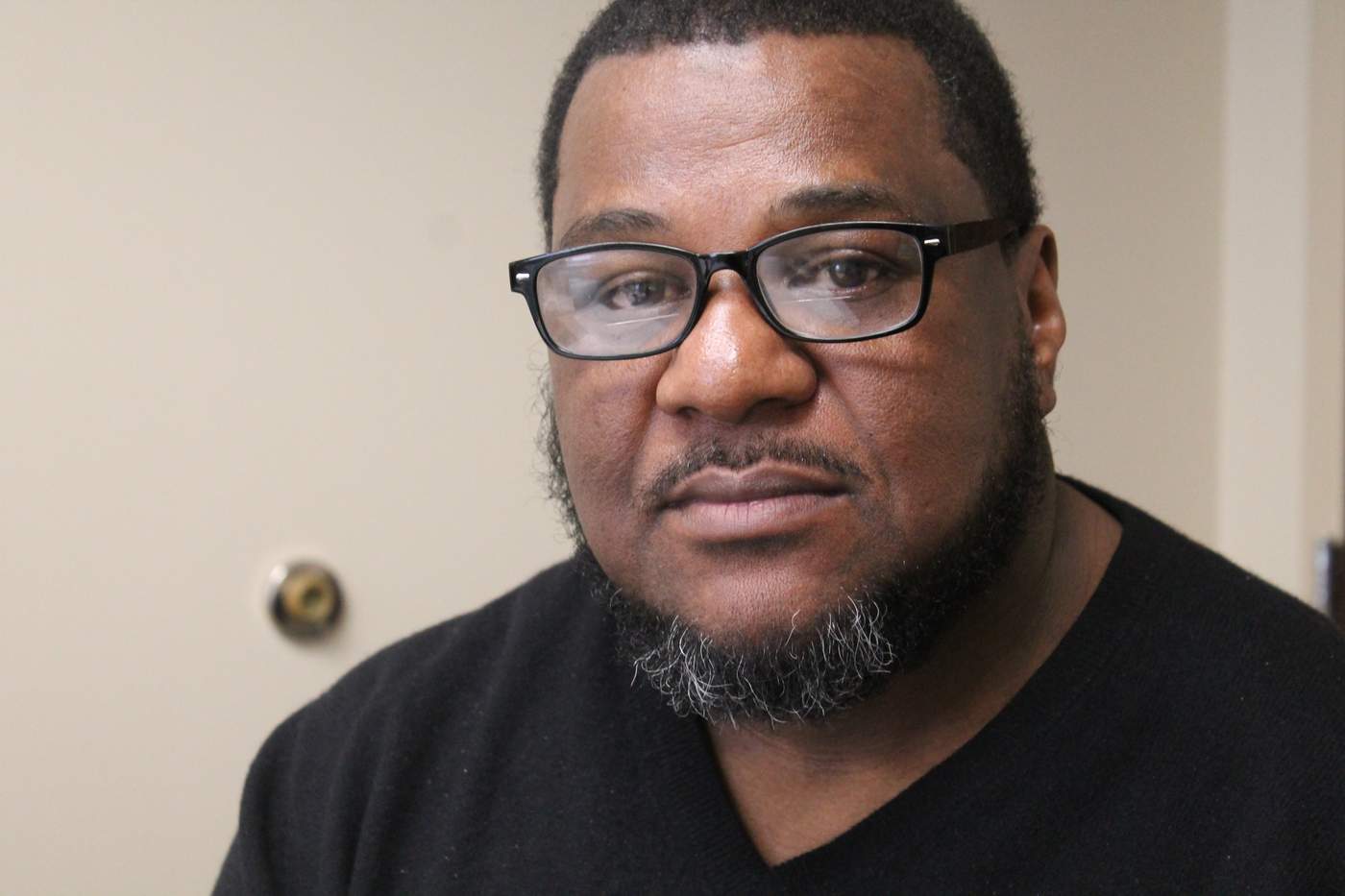
Shawn Whiting
Although they were lauded for their arrest numbers, it was common for the cases to get dropped - a BBC analysis found under Jenkins, roughly half of their cases were never prosecuted.
Bates was able to get Stevenson’s charges dropped after he showed that Jenkins violated Stevenson’s constitutional rights during the initial stop. Bates says of the 20 cases he took with GTTF officers, 17 were dropped due to similar violations.
Nevertheless, an encounter with the GTTF could still have life-altering consequences. In 2016, Jenkins and his men pulled over 28-year-old Andre Crowder Jr and charged him with gun possession.
The case against Crowder was dropped after the officers were indicted. But in the three days he was locked up after his arrest, he learned his three-year-old son Ahmeer had contracted a serious case of pneumonia. As soon as he bailed out, Crowder went straight to the hospital and says he was only in the room for 30 minutes before machines started beeping and the room filled with doctors. Eventually someone emerged from the operating room to deliver terrible news. At the same time he was fighting the case, Crowder had to bury his son.
“I just wish that I can get the time that they took from me,” says Crowder. “I just wish that I could get that back.”
Listen to Andre Crowder talk about what the GTTF took from him
It wasn’t just defendants and their lawyers who raised the alarm early about Jenkins or his officers. Members of the Baltimore Police Department, the Baltimore City State's Attorney’s office, and city judges flagged the officers for lying - but it never seemed to be enough to derail their careers.
In the state of Maryland, the contents of police officers’ Internal Affairs files are protected by law. However, after the GTTF indictments, fragments of the files began leaking to journalists.
For example, in 2009, a motorist accused Jemell Rayam, along with another officer, of stealing $11,000 from him. According to the Internal Affairs file, Rayam pretended that he’d never met the other officer, until investigators pulled records showing that Rayam called his phone almost every day. Rayam later admitted the two were close friends, and on the stand in 2018, he admitted he took the money.
In November 2015, a woman complained to Internal Affairs that members of the GTTF held her at gunpoint to stop her from dialling 911. A leaked internal memo shows that the head of the Baltimore City State’s Attorney’s police integrity unit referred the case to Internal Affairs, requesting an investigation and pointing out that a judge ruled Rayam’s account of what happened “intentionally or recklessly false”.
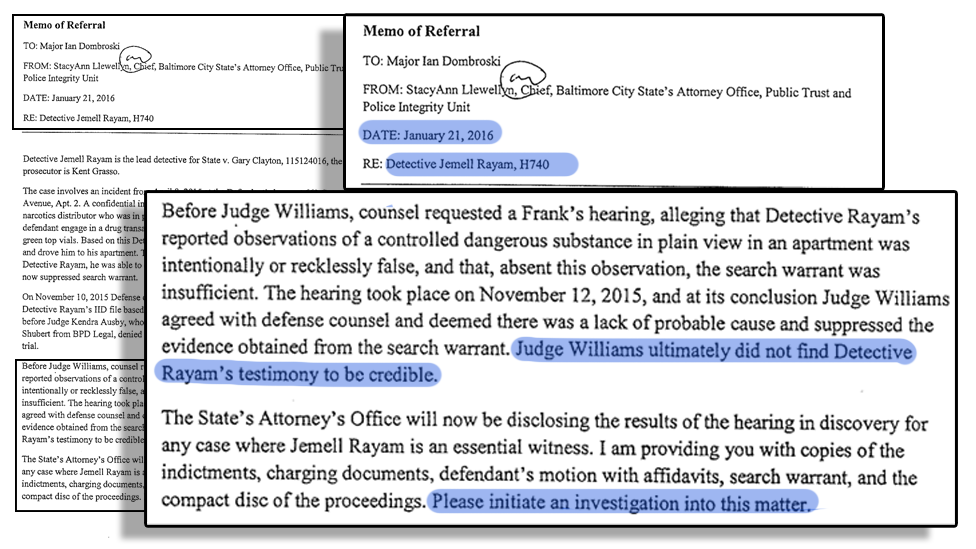
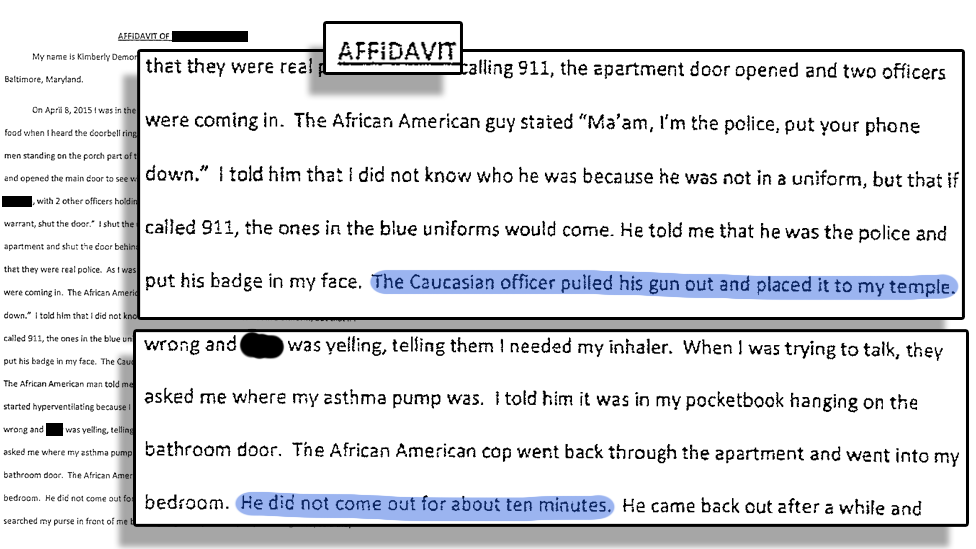
Internal memo on Rayam's "intentionally or recklessly false" testimony
In 2014, an assistant state’s attorney named Molly Webb told “anybody that would listen” that Jenkins was untrustworthy.
It stemmed from the traffic stop of a man named Walter Price. According to the police report, Jenkins and other officers found seven grams of cocaine tucked into the visor of Price’s van.
But Webb says she was floored by the inconsistencies between a closed circuit video of the incident and the probable cause statement, written by a subordinate officer of Jenkins’. She dropped the case and says she notified her superiors. An Internal Affairs investigation into the incident sustained a charge of “failure to supervise” against Jenkins.
During this process, Webb says Jenkins sent her a lengthy text message she found frightening.
“States attorneys are informing me that you believe I’m a dirty cop that should be fired,” a text from a number associated with Jenkins' family from May 2015 reads. “It’s slander and hurtful to me what is being said. This is not a promise, nor is it a threat to you in anyway shape or form this is just hurting me and my reputation.”
At the same time, multiple defence lawyers have complained about getting access to Internal Affairs files from the Baltimore Police Department and the State’s Attorney’s Office, and asked why officers with problematic histories were still allowed to testify.
Through statements provided to the BBC, a spokeswoman for Mosby strongly disagreed that their office failed to readily disclose Internal Affairs files when required, and wrote that they “started providing an additional disclosure on Rayam” to defence lawyers after a 2015 complaint.
“We made disclosures in every case in which credibility was an issue,” she wrote.
“We did not have knowledge of anything with the IA files that would suggest that a larger criminal conspiracy was afoot.”
Mosby’s office also pointed out that before the officers’ indictments, the Baltimore Police Department did not regularly provide them with updates on Internal Affairs investigations.
Under a new agreement, they now receive a report on Internal Affairs complaints every week and a monthly list of suspensions.
A spokesman for the Baltimore Police Department called it “revisionist history” to think the files could have predicted the GTTF’s misconduct.
In June 2016, Jenkins took over the GTTF, giving him citywide jurisdiction, and brought several officers along with him who had internally documented problems with money and truth-telling. Bates, who thought Jenkins would be permanently sidelined by the outcome of the Price case, was dismayed.
“It’s sort of almost like a bad horror movie,” says Bates. “Every time you kill the villain, it comes back to life.”
On the first day of the highly anticipated Gun Trace Task Force trial, former detective Hersl emerged from a wooden door at the back of Judge Catherine Blake’s courtroom, a US Marshal by his side, dressed in khakis and a navy blazer. He nodded to his parents and siblings, seated in a row near the top of the stadium-style seating gallery. Marcus Taylor followed in a navy coat and tie, with a small wave to his parents and extended family. Both men had been incarcerated since the day of their arrest.
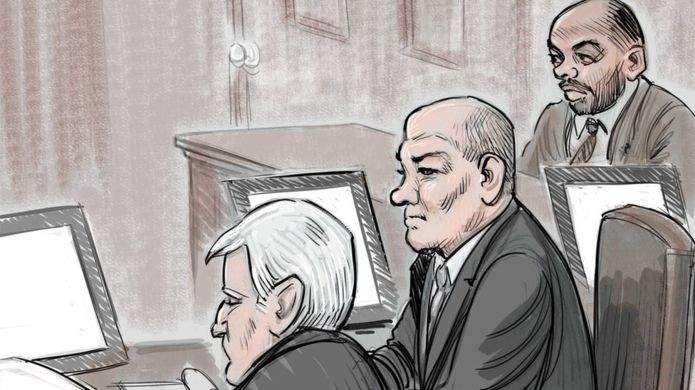
Hersl (centre) and Taylor (right) in court. Court sketch by Tom Chalkley
The government was represented by two over six-foot-tall assistant US attorneys, Leo Wise and Derek Hines, dubbed the “Twin Towers of Justice” as much for their stature as for their rigid, methodical style in court.
“The police officers in this case were entrusted with these,” Wise told the jury, holding the men’s badges and guns aloft. “They can be used for good. They can be used for evil.”
The first witness was former detective Maurice Ward. He entered in a bright green prison shirt, loose pants and rubber shoes, his hair and beard overgrown. As he waited to be sworn in, his bleary eyes scanned the audience for a familiar face. He did not appear to find one.
Over the course of two days, Ward walked the jury through years of robbery incidents going back to 2009, ones committed with Taylor, Hendrix and Jenkins when they were on a narcotics squad together, and ones committed with Hersl, Gondo and Rayam when they all joined the GTTF.
Ward explained the door-pops and the profiling. He said that Jenkins advised them to carry BB guns to plant if they ever shot an unarmed person. After the Stevenson robbery, Ward claimed he scattered the cash in a field behind his house, too scared of getting caught to spend or save it.
“You don’t want to be the one in the squad saying, ‘I’m not with that,’” he said. “You don’t want to be blackballed.”
The former officers testified in the same order in which they had pleaded guilty. Day after day they confessed to their crimes, and clashed with defence lawyers who tried to undermine their credibility.
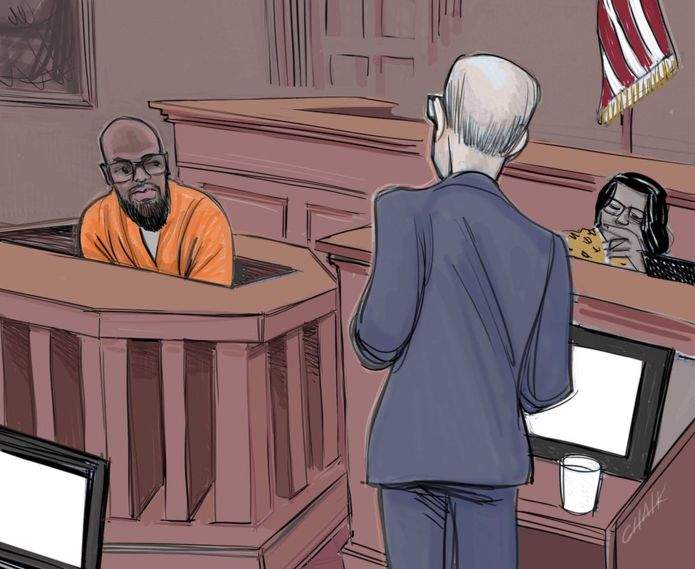
Gondo on the stand. Court sketch by Tom Chalkley
“You lied on at least 13 probable cause statements,” said William Purpura, Hersl’s lawyer, as he cross-examined Rayam.
“I totally understand my faults, sir.”
“You lied to juries, juries like this one,” Purpura continued. “You stole money. You stole narcotics. You stole guns… You can’t stop lying.”
“I’m not lying now,” Rayam said. “It’s never too late to do the right thing.”
The jury heard from eight robbery victims. Shawn Whiting displayed the letters he wrote in prison. Oreese Stevenson, who had to be subpoenaed to get him to show up for court, testified tersely about his experience. Ronald Hamilton told the story of his long night with the GTTF. For his final question, Wise approached him with a watch in a plastic evidence bag - Hamilton identified it as a Breitling watch that went missing from his bedroom during the raid.
The defence lawyers went after Hamilton particularly hard. They showed the courtroom how much money he lost gambling each year, they put up photos of his home and demanded to know how he could afford such a place. As Taylor’s lawyer ticked through a series of photos of the finished basement and the gleaming kitchen countertops, Hamilton snapped.
“They came in my house and destroyed my life. My kids are scared to come in the house, I’m getting divorced because of this,” he yelled, swearing. “This right here destroyed my whole family!”
Judge Blake instructed the jury to disregard his outburst, though it seemed like an impossible request.
The following day, like a man stepping out from behind the curtain in Oz, a 51-year-old bail bondsman named Donald Stepp took the stand. Nattily dressed in a grey suit and rectangular glasses, Stepp explained matter-of-factly that in addition to being a co-founder of Double D Bail Bonds, he was also a cocaine dealer now facing the possibility of life in prison.
Stepp had known the Jenkins family for 40 years, and met Wayne at a cops’ card game. They became friends. They partied together at strip clubs with Stepp’s Dominican cocaine source. When the Baltimore Ravens went to the Super Bowl in 2013, they travelled to the game in New Orleans together.
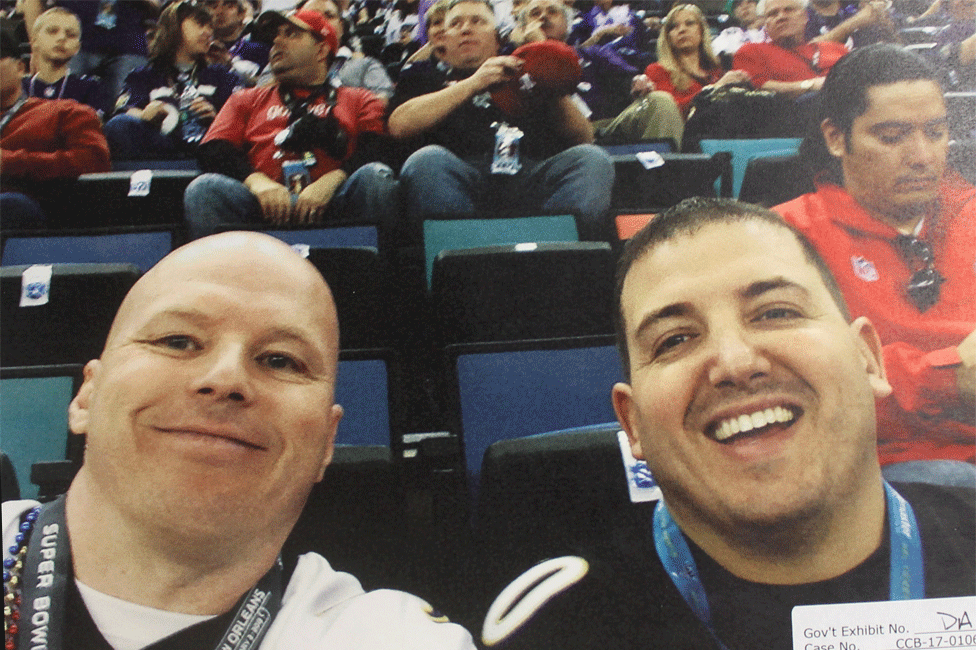
Stepp and Jenkins at the Super Bowl
At some point, Jenkins asked Stepp if he’d be willing to help re-sell stolen drugs.
“I thought it was a winner,” said Stepp. “It was greed.”
Jenkins would deliver large quantities of narcotics on an almost nightly basis to a shed Stepp left unlocked. Stepp was most interested in cocaine, but said Jenkins left every conceivable type of drug, from crack cocaine to Ecstasy to heroin.
At one point, Hines pulled up Stepp’s Amazon purchase history which included orders for the sledgehammer, the masks, the grappling hook, the machete - just about everything that was found in the back of Jenkins’ van. Hines also showed the jury multiple pictures from Stepp’s mobile phone, including a blurry picture of some of the GTTF officers standing outside Stevenson’s home during the raid.
That day, Stepp said Jenkins called to tell him: “I got a monster”. When Stepp arrived, Jenkins walked out of the house with his Baltimore police vest stuffed with cocaine.
“He come out the door looking like Santa Claus.”
After the indictments, Stepp got nervous and threw seven watches worth about $200,000 into the lake behind his home.
Hines produced Ronald Hamilton’s watch, which Stepp confirmed was one that he threw into the water, only to be retrieved later by an FBI dive team.
“I thought I was going to get through, to be honest,” said Stepp. “I didn’t think [Jenkins] would reveal me.”
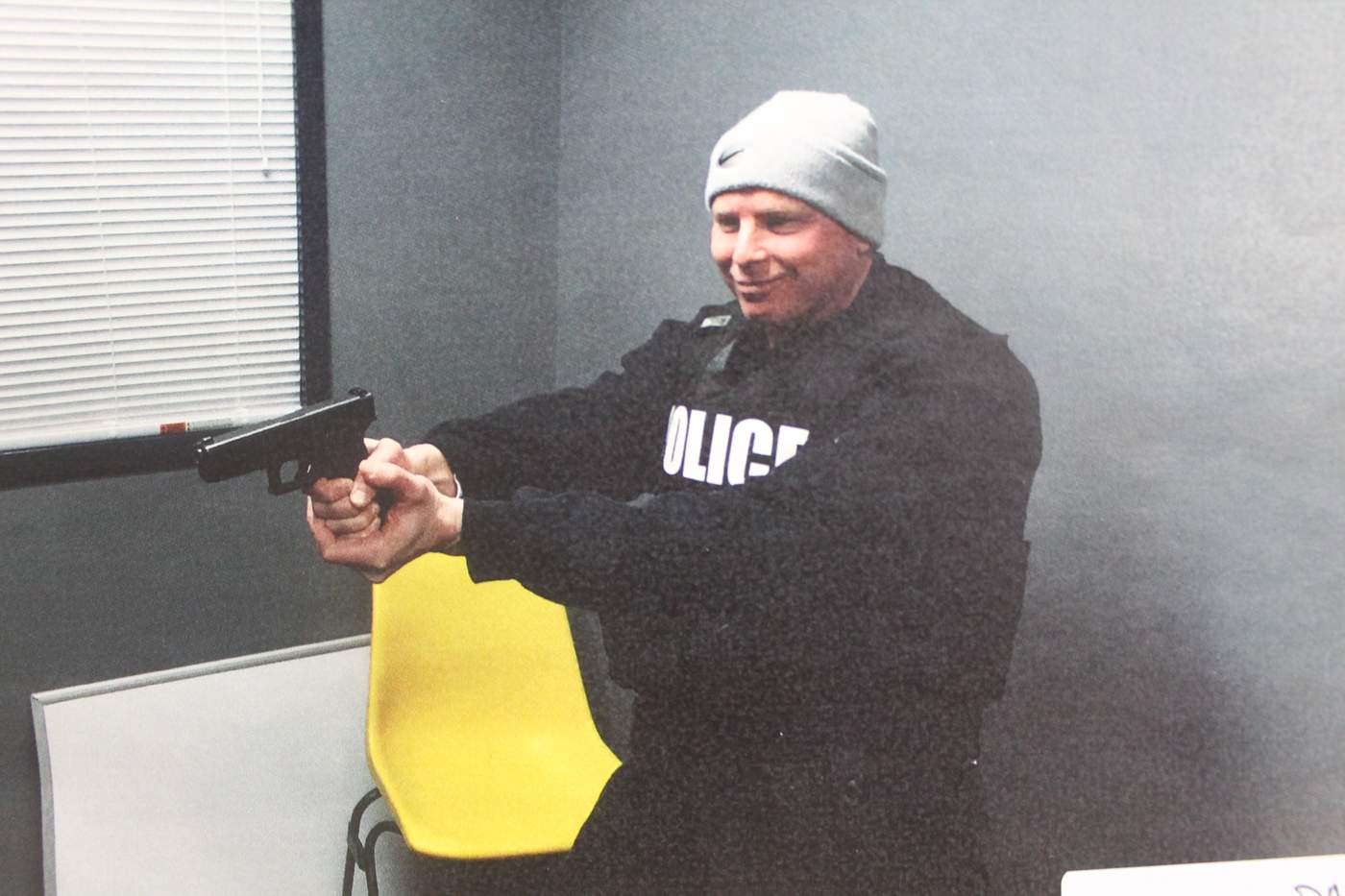
Stepp wears Jenkins' vest and holds his gun at BPD headquarters.
Hersl’s lawyer, Purpura, admitted his client had taken money, but argued that it was theft, not robbery, and the government had overcharged him.
He got current Baltimore police officers to admit on the stand there was a long-standing department practice of offering overtime as a reward for seizing a gun.
Taylor’s lawyer tried to convince the jury that “he sits before you, innocent”.
When word came that, after two days, the jury had a verdict, a tremulous man named Alex Hilton walked into the courthouse. He’d been arrested by Hersl multiple times, and was clearly disturbed by what he went through.
“If he was to get convicted, it would be some semblance of justice for me, I could have some closure, move on with my life without being afraid,” he said, his whole body trembling with emotion. “These are cops we’re talking about, for crying out loud.”
In the courtroom, Judge Blake read down the list of charges, and the jury foreman rose.
“We, the jury, find the defendant Daniel Thomas Hersl, guilty,” he read. “We, the jury, find the defendant Marcus Roosevelt Taylor, guilty.”
Jovonne Walker was arrested by Jenkins and the case was later dropped. She talks about her reaction to his arrest
As the officers’ family members silently held on to one another, Hilton clasped his hands together. “Thank you, Jesus.”
The jury convicted Hersl and Taylor on most, but not all charges. They determined the men had committed robbery, extortion and fraud, but cleared them of firearms charges. As the US marshals clicked the handcuffs closed on their wrists, Hersl’s family called out to him.
“Stay strong, Danny,” and “I love you, Danny.”
While the Taylor family walked briskly out of the courthouse without saying a word, Stephen Hersl, a retired firefighter and Daniel’s older brother, broke down in front of the television cameras.
“My brother was innocent and it was obvious,” he said, his face wet with tears. “Let’s talk about the corruption on top - everybody starts from the bottom, the little guy. My brother was a little guy.”
He vowed that someday, Daniel would write a book and out the superiors who’d allowed the GTTF to happen.
“Baltimore city, they can’t run a school system, they can’t run a police department, they can’t even run a zoo, Baltimore city!”
He abruptly turned and walked off into the night, as the sound of a lone, plaintive siren filled the night air.
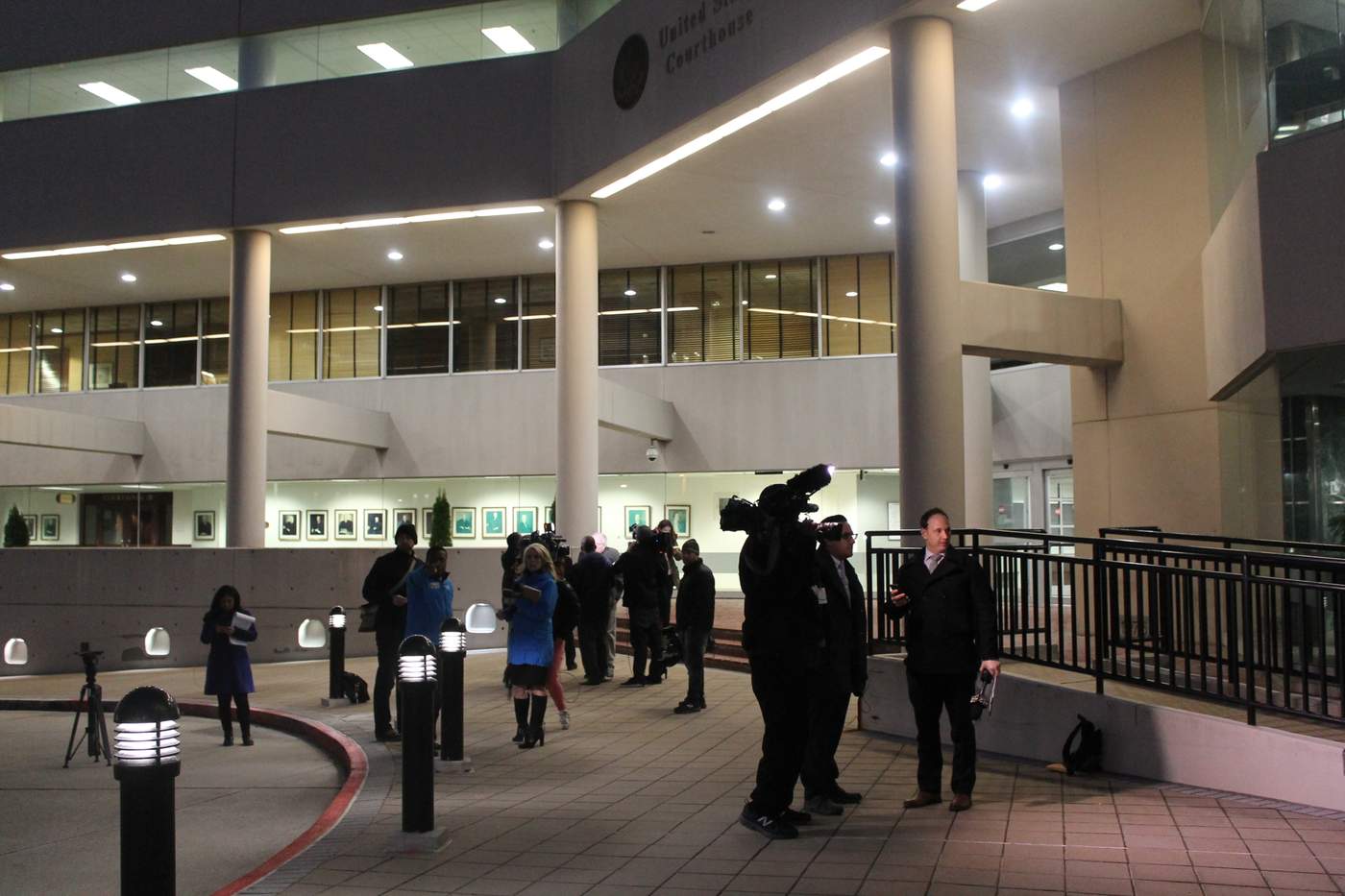
Four days after the verdict, now-Corporal David McDougall sat in his black SUV outside of the federal courthouse as a cold rain misted the windows. He had eschewed his typical plaid shirt and jeans for a suit.
“This is an important day for the investigation,” he said. “It’s been a crazy journey.”
Moments earlier, Antonio “Brill” Shropshire was sentenced in front of a packed audience, including his mother, father, his two grandmothers and dozens of other friends and family who watched the proceeding with red-rimmed eyes. Several begged Judge Blake to spare Shropshire the maximum sentence so he could one day come home to his young son. McDougall sat at the prosecution’s table, alongside Wise and Hines.
Shropshire, a tall, bearded man in a maroon prison uniform, called McDougall and the government’s lawyers “liars”, and continued to deny he was ever the leader of a large-scale heroin operation. But he also promised to lead a crime-free life if he were allowed to return home.
“Heroin kills people, Mr Shropshire,” said Judge Blake. “Mr Shropshire continued to sell this poison. Does that mean he’s a monster? Of course not.”
She sentenced him to 25 years in prison. Both Shropshire and Glen Kyle Wells are appealing against their convictions.
McDougall said he thought the sentence was fair, and was pleased by the guilty verdicts at the GTTF trial. But he doesn’t get too emotional about this stuff.
“It’s just part of the job. Just going through the steps now.”
None of the eight officers has been sentenced - Judge Blake is expected to make those decisions in spring. Hendrix, Ward, Allers and Rayam are facing 20 years; Gondo, Hersl and Taylor could get up to 60 years.
Wayne Jenkins is expected to receive between 20 and 30 years in federal prison. Should he choose to make a statement, the sentencing would be the first time the public will hear directly from him. Through his lawyer, he declined to comment for this story.
It will also be the first opportunity his victims will have to address him, a day that Ronald Hamilton is eagerly awaiting.
“I’ll be the first one,” he said. “This has ruined me. This has crushed me.”
In the course of testimony, the names of an additional 11 current and former Baltimore city police officers came out, including a former partner of Jenkins’ and a high-ranking deputy commissioner. None has been charged, and a spokesman for the Baltimore Police Department says they are actively investigating the allegations raised at trial. One commander was demoted. Two lieutenants who directly supervised Jenkins remain on the force.
“It ain’t over. It’s just begun,” says Shawn Whiting, who pointed out his arrest involved additional officers. “It’s way far bigger than people think.”
Baltimore mayor Catherine Pugh fired Commissioner Kevin Davis the Friday before the GTTF trial began, citing “impatience” with the climbing homicide rate. Davis was replaced by his deputy commissioner Darryl De Sousa, who announced a slew of reforms, including random ethics tests and polygraphs for officers. According to a spokesman, new checks and balances will be implemented to make sure gun cases are tracked from “arrest to adjudication”, and an anti-corruption unit will be established to focus specifically on the misconduct of the Gun Trace Task Force officers.
Critics have questioned how an investigative unit housed within the BPD will be any different than the current Internal Affairs division, which failed to root out the GTTF officers.
“We still believe we have the capability to investigate on our own - we have to, that’s the bottom line,” says TJ Smith, chief of media relations.
After years of fighting for the right to view officers’ Internal Affairs files, Deborah Katz Levi, in charge of the public defender's special litigation projects, says that a month after the end of the trial she’s suddenly been granted “unparalleled access” to 21 officers’ files, including some members of the GTTF.
Levi says they're now working with the State's Attorney's Office to expand the number of convictions "that need to be undone". The office says their initial assessment concluded that 284 cases - active or closed - have been affected by the seven originally indicted GTTF officers. Mosby's office will only proceed on three active cases. She has also told the media that after factoring in the expanded timeline and additional officers whose names arose at trial, the number of cases involved could rise to “thousands”.
Mosby fired an assistant state’s attorney from her staff in February, but has never said whether this person leaked information to Jenkins.
“The [US Attorney's office] has shared components of its GTTF investigation with our office and we are not at liberty to comment,” Mosby’s spokeswoman wrote.
The ripple effects of the case are constant and ongoing. Andre Crowder and other victims of the GTTF moved away from the city of Baltimore for fear of retaliation. Sticky, the alleged murderer of Davon Robinson, will go on trial this spring. He has pleaded not guilty.
Among Baltimore citizens and police officers alike, there is sharp disagreement on how Sean Suiter died. Earlier this year, the FBI declined to take the case.
A state senator proposed the creation of a special commission with subpoena power to perform a detailed two-year investigation into the GTTF, and answer the lingering questions surrounding the BPD. However, Mayor Pugh says the police department is already under federal oversight, and that her changes to the upper ranks will be sufficient to address the GTTF’s impact.
“I believe in the work that is currently already under way,” she says.
Back in Harford County, new dealers have stepped into the vacuum left by Shropshire and Anderson. There have been 103 overdoses in 2018, so far, putting the county on track for another record breaking year.
McDougall continues to investigate overdoses. He arrives on the scene of parents’ worst nightmares, he removes bodies from childhood bedrooms. He admits there’s a feeling he’s chasing his own tail, sometimes.
“Somebody’s got to do the job,” he says. ”That’s me.”


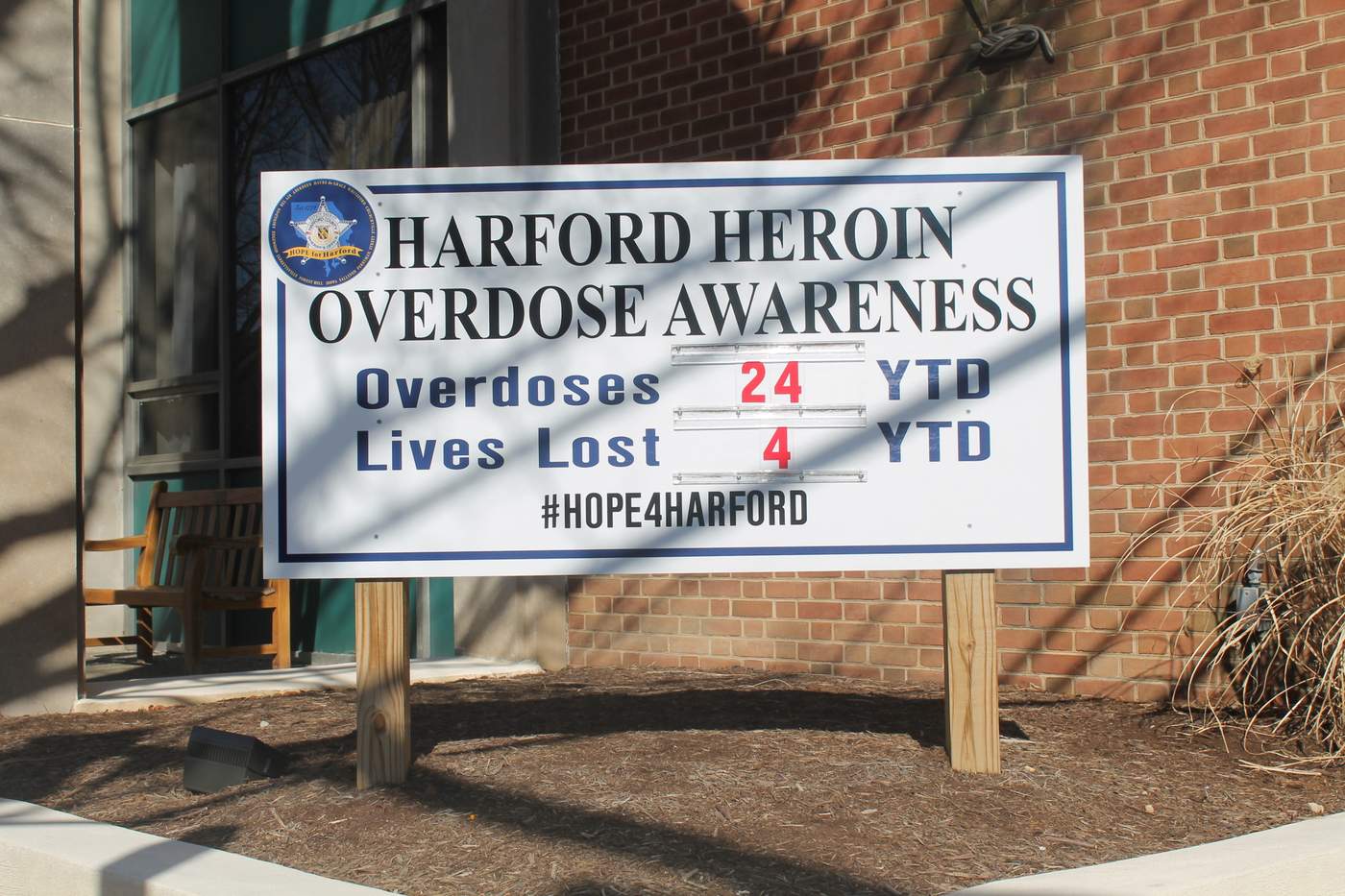
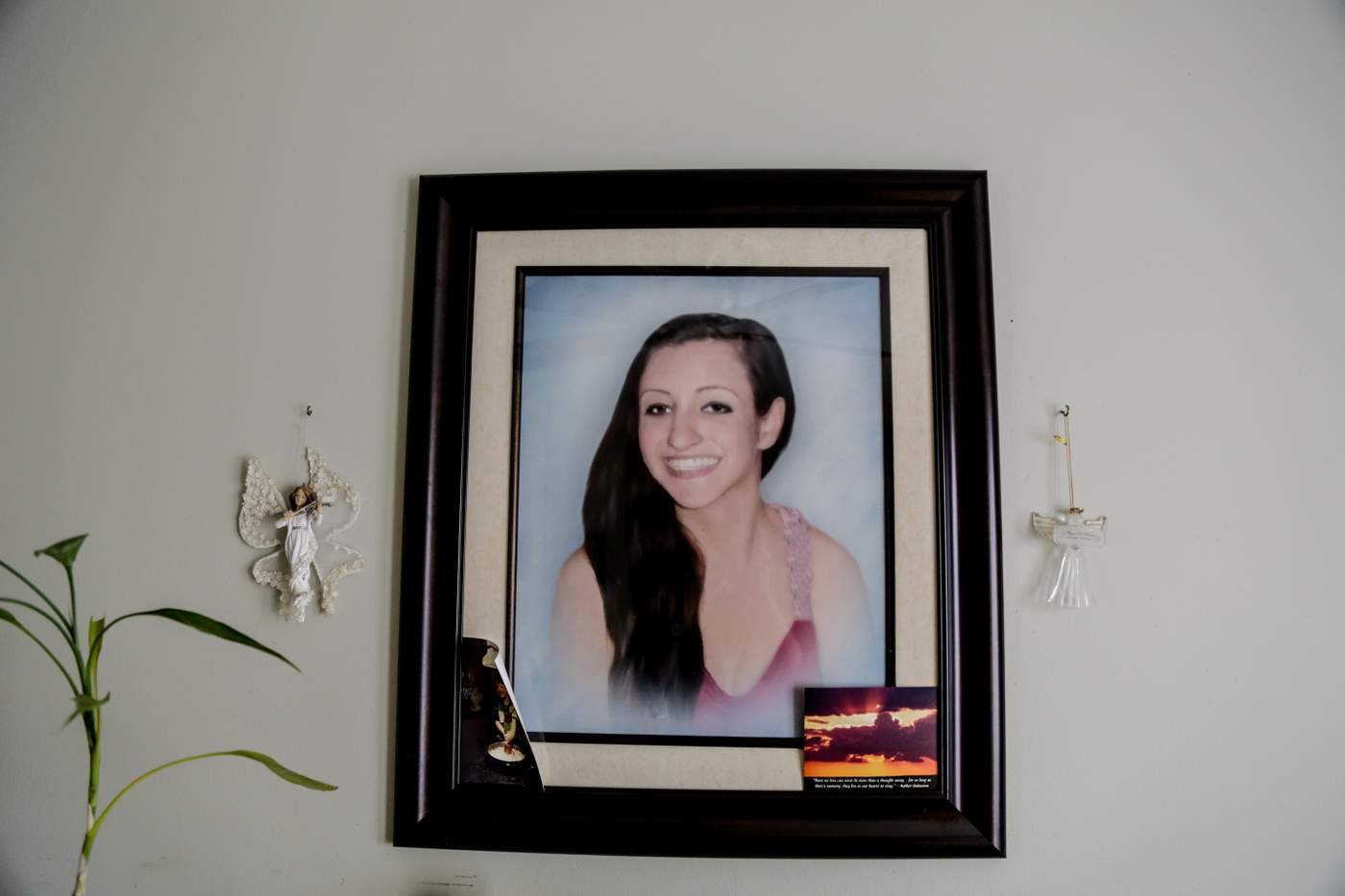
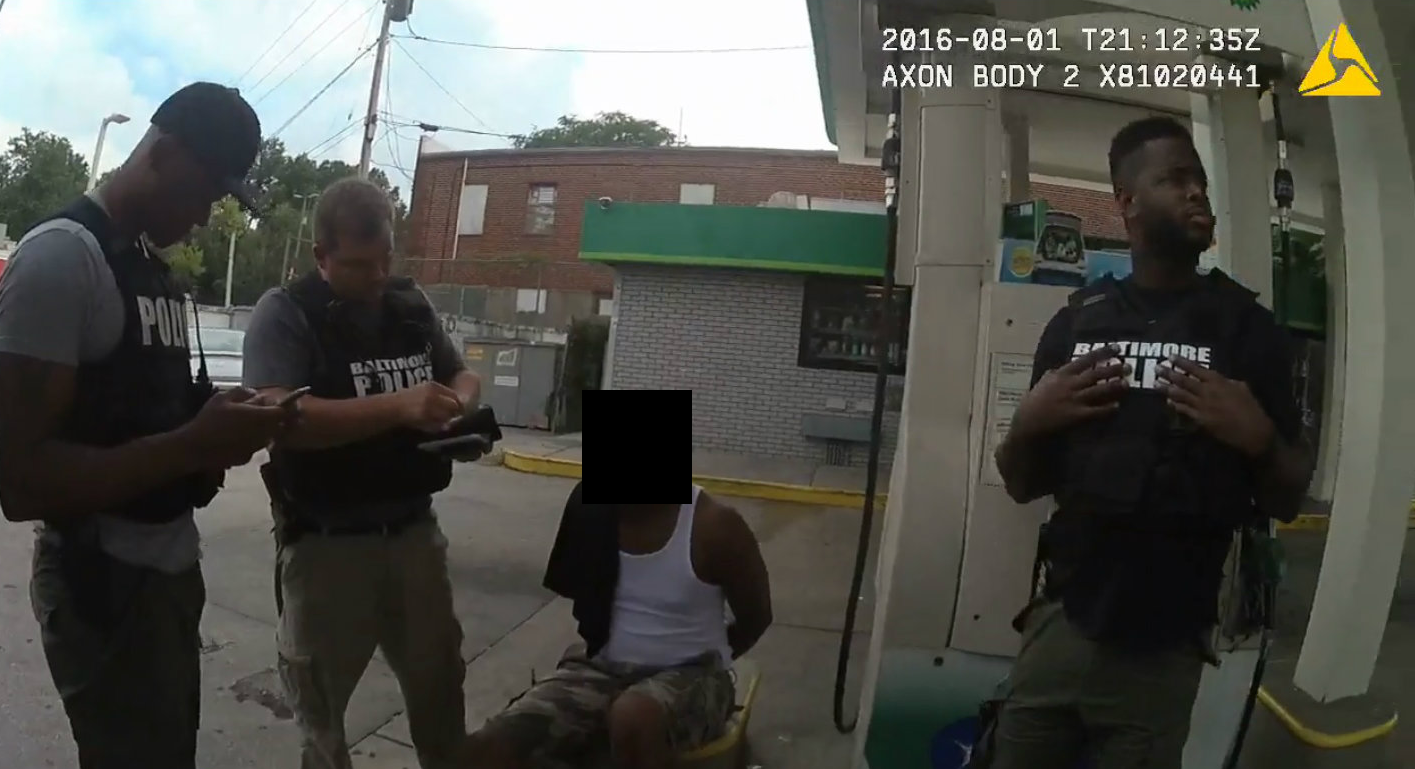
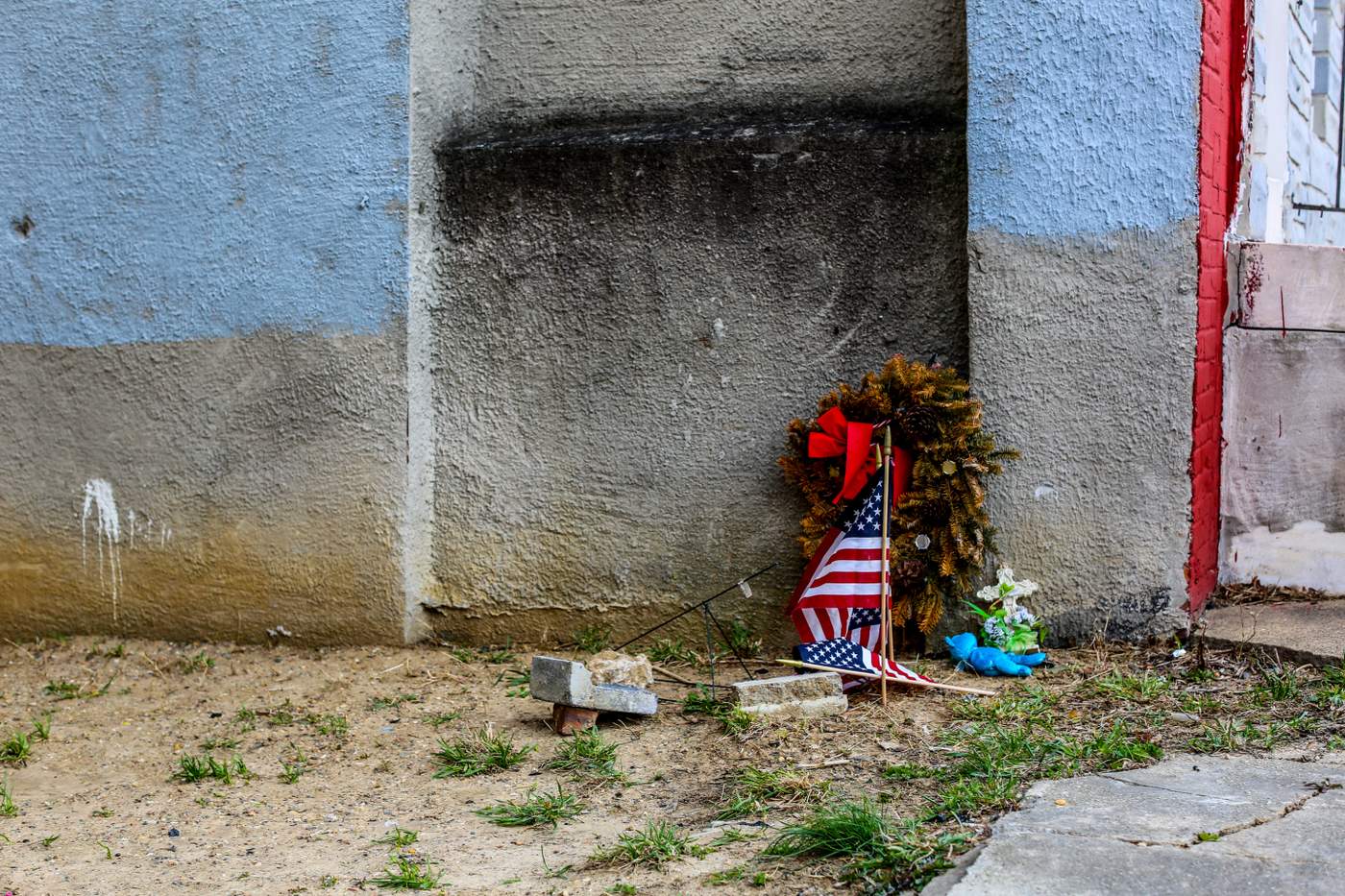
No comments:
Post a Comment